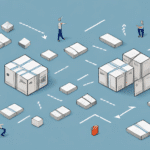Mastering the Transition from 3PL to In-house Operations
For many businesses that rely on supply chain and logistics management, outsourcing to third-party logistics providers (3PL) may seem like the most convenient and cost-effective option. After all, 3PLs specialize in managing transportation, warehousing, and distribution, among other services, which can help alleviate a lot of the stress and burden of logistics management for companies. However, as businesses grow and evolve, the need to bring certain functions in-house becomes more apparent. Making the transition from outsourcing to in-house logistics operations can seem daunting, but with careful planning and execution, it can bring substantial benefits both short and long-term.
Understanding the Role of 3PL Providers
Reasons Companies Choose 3PL
Companies often outsource logistics to 3PL providers for several reasons, including cost savings, flexibility, scalability, expertise, and access to advanced technology and resources. For smaller businesses or those experiencing rapid growth, partnering with a 3PL can provide a fast and efficient way to scale operations without overextending internal resources. Additionally, working with a 3PL allows companies to tap into the provider's expertise and industry knowledge, reducing the learning curve and potentially averting costly mistakes.
Another advantage of 3PL providers is improved supply chain visibility. They often utilize advanced technology and software to track shipments, monitor inventory levels, and analyze other critical data in real-time, enabling companies to make more informed decisions.
Moreover, outsourcing logistics can help reduce environmental impact. Many 3PLs implement sustainable practices and technologies, such as electric vehicles or optimized delivery routes, thereby helping companies align their operations with sustainability goals.
Evaluating the Pros and Cons of 3PL
Advantages of Utilizing a 3PL
- Access to Expertise: 3PLs bring specialized knowledge and experience that can enhance logistics efficiency.
- Cost Efficiency: Potential for cost savings through economies of scale and reduced overhead costs.
- Technology Access: Advanced logistics software and tracking systems improve supply chain visibility.
Disadvantages of Utilizing a 3PL
- Loss of Control: Outsourcing can lead to reduced visibility and flexibility in logistics operations.
- Potential for Increased Costs: Additional services or fees may lead to higher costs if not managed properly.
- Dependency: Relying on a third party may pose risks if the provider faces disruptions.
It's crucial for companies to carefully evaluate their specific needs and strategic goals when deciding whether to utilize a 3PL. Factors such as supply chain complexity, shipment volume, and the desired level of control should all be considered.
Advantages of Bringing Logistics In-house
Enhanced Control and Flexibility
In-house logistics operations provide companies with greater control over their supply chain, allowing for more flexible and tailored logistics strategies that align closely with business objectives.
Cost Optimization
By managing logistics internally, businesses can optimize cost structures without the premium fees often associated with 3PL services. This allows for more precise budget management and cost-saving opportunities.
Stronger Supplier and Customer Relationships
Managing logistics in-house fosters closer relationships with suppliers and customers, leading to improved communication, stronger partnerships, and higher customer satisfaction.
Opportunities for Innovation
In-house operations enable companies to experiment with new technologies and processes, driving continuous improvement and gaining a competitive advantage in the marketplace.
Challenges of Transitioning to In-house Logistics
Initial Investment and Resource Allocation
Transitioning to in-house logistics requires significant upfront investment in infrastructure, technology, and personnel. Acquiring the necessary resources can be particularly challenging for smaller or mid-sized businesses.
Scalability Issues
As a business grows, managing increased logistics demands with an in-house team can become difficult, potentially limiting scalability and operational efficiency.
Expertise and Knowledge Gaps
Building an in-house logistics team requires recruiting skilled professionals and providing ongoing training to ensure expertise and industry knowledge are maintained.
Deciding When to Transition to In-house Operations
Assessing Business Growth and Logistics Needs
Businesses should evaluate their current operational capacity, growth projections, and logistics requirements to determine the optimal timing for transitioning to in-house logistics.
Cost-Benefit Analysis
Conducting a thorough cost-benefit analysis helps in understanding the financial implications and potential long-term savings associated with in-house operations.
Evaluating Internal Capabilities
Assess whether the company has the necessary expertise, technology, and resources to manage logistics internally effectively.
Implementing a Successful Transition Plan
Developing a Comprehensive Implementation Strategy
A detailed plan should outline timelines, budgets, resource allocation, and risk management strategies to guide the transition process effectively.
Training and Supporting Your Team
Providing adequate training and support to your internal team ensures a smooth transition and equips them with the necessary skills to manage in-house logistics operations.
Maintaining Clear Communication
Open and consistent communication with all stakeholders, including employees, suppliers, and customers, is vital to minimize disruptions and ensure alignment throughout the transition.
Measuring Success and Continuous Improvement
Key Performance Indicators (KPIs)
After transitioning, monitoring KPIs such as inventory turnover, order fill rates, and cycle times provides insights into the effectiveness of the in-house logistics operations.
Continuous Optimization
Regularly evaluating performance data allows businesses to identify areas for improvement, ensuring that logistics operations remain efficient and cost-effective over time.
Avoiding Common Pitfalls
Effective Communication
Lack of communication can lead to misunderstandings and operational inefficiencies. Establishing clear communication channels is essential.
Adequate Training
Insufficient training can hinder the effectiveness of the in-house team. Investing in comprehensive training programs is crucial for success.
Robust Technology Infrastructure
Ensuring that the necessary technology and infrastructure are in place helps prevent disruptions and supports efficient logistics management.
Proactively addressing these challenges enhances the likelihood of a successful transition to in-house logistics operations.
Long-term Benefits of In-house Logistics
A successful transition to in-house logistics can lead to increased control and transparency, enhanced flexibility, optimized costs, and greater potential for growth. Celebrating these successes with your team fosters a sense of ownership and pride, positioning your business for sustained success in the competitive marketplace.






















